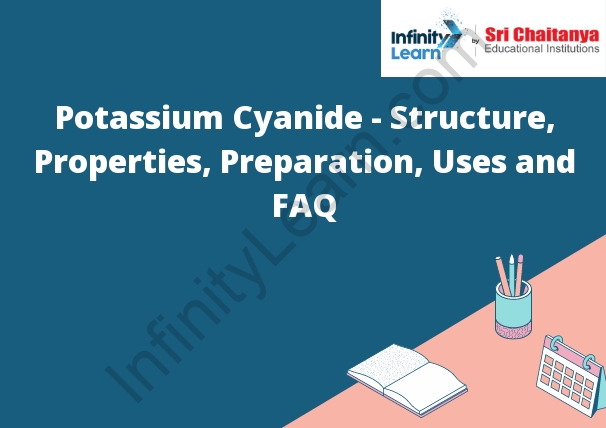Table of Contents
Potassium Cyanide – A Form of Cyanide
Potassium Cyanide – Structure: Potassium cyanide (KCN) is a cyanide salt with the formula KCN. It is a white solid that is soluble in water. It is a potent inhibitor of cellular respiration, acting on the cytochrome c oxidase complex in the mitochondrial membrane. This results in inhibition of the electron transport chain and ATP production.

More About Potassium Cyanide
Potassium cyanide (KCN) is a chemical compound with the formula KCN. This colorless crystalline salt, similar in appearance to sugar, is soluble in water. It is a cyanide compound, consisting of a potassium cation and a cyanide anion. It is used in mining, electroplating, and organic synthesis.
Structure of Potassium Cyanide
- Potassium cyanide is a white crystalline powder with a bitter taste. It is an extremely poisonous material that can kill quickly. The structure of potassium cyanide is shown below.
- Potassium cyanide is a white crystalline salt with a salty taste. It is soluble in water and in alcohol. It is produced by the reaction of potassium hydroxide with cyanide.
- The structure of potassium cyanide is shown below.
- The potassium ion is surrounded by six cyanide ions in a cubic close-packed arrangement.
Properties of Potassium Cyanide
- Potassium cyanide is a white, odorless, and deadly powder. It is soluble in water and can be fatal if ingested or inhaled. It can also cause skin and eye irritation.
- Potassium cyanide is a white, odorless, and bitter-tasting powder that is soluble in water. It is a deadly poison that can kill within minutes.
- Potassium cyanide disrupts the ability of cells to use oxygen, causing them to die. It is used in gold mining and other industrial processes.
Preparation of Potassium Cyanide
1. Weigh out about 0.5g of potassium into a small beaker.
2. Add about 5mL of water to the potassium.
3. Add a few drops of hydrochloric acid to the potassium.
4. Stir the mixture until the potassium is dissolved.
5. Add more water to the beaker until it is about half full.
6. Gently swirl the beaker to mix the solution.
7. Carefully pour the solution into a small test tube.
8. Add a few drops of silver nitrate solution to the test tube.
9. Observe the reaction that occurs.
Uses of Potassium Cyanide
- The most common use of potassium cyanide is in gold mining. It is used to extract gold from ore.
- KCN is a molecule that consists of a potassium ion (K+) and a cyanide ion (CN-). It is a colorless, odorless, and poisonous gas. KCN is used in a variety of industrial processes, including the production of fertilizer and plastics. It is also used as a fumigant to kill pests.
- KCN is extremely toxic. Inhalation of even small amounts can cause death within minutes. Symptoms of poisoning include headache, dizziness, confusion, and vomiting. The body’s natural defenses against cyanide poisoning include rapid heart rate and release of adrenaline. These defenses can lead to heart attack and death.








